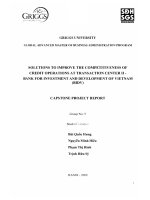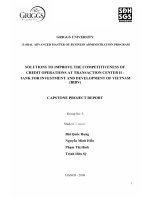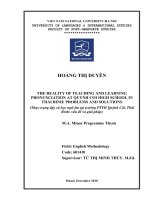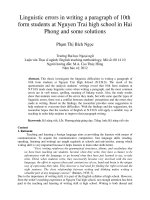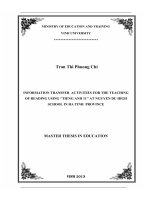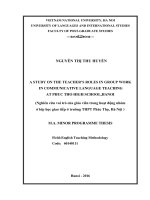Applying blog to motivate the students of class 11a4 at quynh tho high school in studying writing skill
Bạn đang xem bản rút gọn của tài liệu. Xem và tải ngay bản đầy đủ của tài liệu tại đây (561.3 KB, 56 trang )
MINISTRY OF EDUCATION AND TRAINING
HANOI PEDAGOGICAL UNIVERSITY N
o
2
TRINH THI PHUONG LIEN
APPLYING BLOG TO MOTIVATE THE STUDENTS OF
CLASS 11A4 AT QUYNH THO HIGH SCHOOL IN
STUDYING WRITING SKILL
(GRADUATION PAPER SUBMITTED IN PARTIAL FULFILLMENT OF
THE DEGREE OF BACHELOR OF ARTS IN ENGLISH)
SUPERVISOR: NGUYEN THI HA ANH, M. A
Hanoi, May 2014
ii
ACKNOWLEDGEMENTS
I would like to take this chance to express my greatest gratitude to
Nguyen Thi Ha Anh, MA, my supervisor, for her patience in providing
continuous and carefully guidance as well as encouragement, indispensable
suggestions and advice.
I wish to thank all the lectures at Hanoi Pedagogical University Number
2, especially the lectures in the Foreign Language Faculty for their dedicated
instructions during my years of university work.
I am particularly grateful to my close friends for their enthusiasm and
kindness in helping me collect valuable reference documents and data for my
research.
Last but not least, I owe a debt of gratitude to my beloved family, for their
whole-hearted encouragement and endless support.
iii
ABSTRACT
Writing is viewed hugely important, yet it is a daunting task for both
English as a second language (ESL) teachers and learners. With the
development of different approaches to teaching in general, numerous
approaches to the teaching of writing have been evolved such as product,
process and post process approaches. Although these approaches have changes
the role and status of writing over the years. Writing still appears as one of the
difficult areas to tackle as students lack academic writing skills and they are de-
motivated to write in English. In view of this, researcher shows an interest in
looking into the possibilities of using Information and Communication
Technology (ICT) tools for language teaching and learning and Blog is known
as an effective method in ESL classrooms. The aim of this study is to apply
blogs in developing the writing skills of ESL learners. The study will further
highlight the benefit of weblogs logging activities and the impacts of these
activities on students‟ motivation to write in English as autonomous learners.
iv
STATEMENT OF AUTHORSHIP
Title: Applying Blog to Motivate the Students of Class 11A4 in
Studying Writing Skill at Quynh Tho High School.
I certify that no part of this report has been copied or reproduced by me
from any other person‟s work without acknowledgements and that the report is
originally written by me under strict guidance from my supervisor.
Date submitted: May 2014.
Student
Trinh Thi Phuong Lien
v
LIST OF FIGURES
Figure 1: The use of blog in the students‟ previous writing classes
Figure 2: The experience with blog of the students before this writing
Figure 3: The students‟ ideas about writing and giving feedback through paper
Figure 4: The method which the students like better: traditional (paper/ pencil)
or blog
Figure 5: The feeling of the students about using blog in writing
Figure 6: The studentsattitudes towards using peer feedback to complete writing
vi
TABLE OF ABBREVIATIONS
EFL : English Foreign Language
ESL : English Foreign Language
ICT : Information Communications Technology
vii
TABLE OF CONTENTS
ACKNOWLEDGEMENTS ii
ABSTRACT iii
STATEMENT OF AUTHORSHIP iv
TABLE OF CONTENTS v
Chapter 1: Introduction 1
1.1. Rationale 1
1.2.Research questions 3
1.3. Research objectives 3
1.4. Research scope 3
1.5. Research tasks 4
1.6. Significance of the proposed research 4
1.7. Design of the research work 5
Chapter 2: Development 6
2.1. Literature review in brief 6
2.2. Blog 8
2.2.1. Definition of blog 8
2.2.2. Characteristics of blog 10
2.2.3. Functions of blogs in development of writing skills 12
2.2.3.1. Benefits of using blog 12
2.2.3.2. Challenges in using blog 14
2.3. Writing 15
2.3.1. Definition of writing 15
2.3.2. The types of writing 15
2.3.3. Audience 16
2.3.4. Context 16
2.3.5. The characteristic of good writing 16
2.3.6. The importance of writing 17
2.3.7. The process approach for teaching writing 17
viii
Chapter 3: Research Methods 20
3.1 Rationale 20
3.2 Participants 21
3.3. The setting 21
3.4 Research instruments 21
3.5 Procedure of the study 23
3.6 Data analysis procedure 25
Chapter 4: Results and Discussion 27
4.1. The attitude of students before using blog 27
4.2. The attitude of students after using blog 32
4.3. Discussion 35
Chapter 5: Suggestion and Conclusion 37
5.1. Conclusion 37
5.2. Limitations 39
5.3. Suggestions for further study 39
APPENDICES 40
APPENDIX A 40
APPENDIX B 41
REFERENCES 45
1
Chapter 1: INTRODUCTION
1.1. Rationale
Nowadays, the internet has emerged as a prominently new technology and
played an important role in learning and teaching English in Vietnam. The
influence of such a powerful technological tool has pervaded all aspects of the
education, business and economic sector of our life. We can find any kind of
references on internet very quickly and internet widely spreads in numerous
fields and domains. The technology has a lot benefits in learning foreign
language. The use of technology helps teachers and students in different ways.
Besides, it helps to motivate students to learn four English skills. Students have
opportunities to work in collaborative manner and share what they know or what
they do not know with friends all over the world. “Technology gives students
opportunities to use their productive and receipt ability for real purposes, such
as publishing a new letter or writing interactive journals” (“school computing”,
e-book). Face book, Twitter, Google, Zing me or Weblog, etc are social
networks applied as means of technology in order to support for students in
learning English. Students can share thoughts, photos, music, links, ECT
through social networks and they can communicate with all friends all over the
world, and do research.
The term “blog” is a contraction of two words: web and log. Blog is
known as a tool for written communication and interaction. The term weblog
refers to a personalized webpage, kept by the author in reverse chronological
diary form. Blogs are personal online journals which have recently become a
collaborative technology, regarded as a new way for people to express their
thoughts in public. The form of writing has become popular among internet
uses. Most blog writers (bloggers) use this environment, as writing in blogs to
help people become more thoughtful and critical in their writing. Blogs can also
be used to publish and exchange personal knowledge. The idea of using blogs in
language learning is similar to the use of journal writing which is a way to help
2
students explore and assimilate new ideas, create links between the familiar and
unfamiliar, mull over possibilities, and explain them to others. Every student can
get chance to express himself or herself and publish his/her thoughts. On the
other hand, the teacher and other students can contribute their understanding on
the publication. Hence, the students can strengthen their knowledge, by
constructing their own meanings in writing and interpret these meanings based
upon their understanding and experiences. Blogs, therefore, should be used to
promote writing skill among ESL learners.
The differences in the system of language may bring about learning
problems for foreign language learners. Hence, Vietnamese students face
difficulties in writing. There are four component skills in learning English,
namely: reading, writing, speaking and listening. In other word, writing can be a
way of expressing ideas through written form. By writing, we can compare our
opinion with the people who read our writing. Writing can be considered as
media in expressing feeling and self expression and it can be enjoyed not just for
the writer itself but also for the reader. That is why people write to express their
feelings, ideas, or thoughts and to be read by other.
In teaching four skills, there are many techniques usually used by teacher.
But a lot of teachers say that they face difficulties in teaching writing English
because it is not easy to find out the effective way to motivate students in
writing lesson.
Blog is viewed as a tool in facilitating the development of writing skills to
ascertain such contention. Several research studies concur that the use of a blog
can positively enhance learning in the second language classroom. Moreover
blog can improve writing skills. Research has confirmed positive uses of the
blog which include writing for an audience and peer review, the development of
a sense of community in a class through a collaborative learning environment.
Blog can stimulate student‟s interest and also increase the student‟s ability in
writing especially in making sentences.
3
In fact, after I practiced teaching English writing at class 11A4 of Quynh
Tho high school, I knew that many students did not like writing because they
were not motivated in writing class. Besides, many of my colleagues said that it
is too difficult for their students to take part in writing class enthusiastically. As
a teacher, I found that applying blog in writing class may help to solve these
problems and improve the students‟ attitude towards writing.
Based on the explanation above, the writer is interested in concluding a
research entitled “Applying blog in teaching writing English at Quynh Tho high
school”.
1.2. Research questions
Base on the rationales above the researcher formulated two research
questions as follows:
1. How blog motivate the students at Quynh Tho high school in writing
skill?
2. How can blog help to improve students‟ writing in English writing
class?
1.3. Research objectives
The study is aimed at the following goals:
To evaluate the effects of blog to facilitate the students at Quynh Tho high
school in English writing.
To find out the benefits of blog in improving the student‟s English
writing.
1.4. Research scope
The research focuses on using the blog to motivate the students in English
writing.
The population involved in the study is 30 students of class 11A4 at
Quynh Tho high school.
4
1.5. Research tasks
The study involves fulfilling the following tasks:
1. To study the effects of blogs on improving writing skill.
2. To apply blogs into practice.
1.6. Significance of the proposed research.
In accordance with the problem stated above, this research is expected to
be beneficial to the following subjects:
For students
1. The students can be more active in learning process, because they can
make cooperation with their group.
2. The students are motivated and feel interested in English writing
through using weblog.
3. The students have tutor that can help them if they find any difficulties
in learning writing skill.
4. To build up consciousness of the importance of writing to support the
mastery of language skills.
For the teacher
English teacher can choose and apply blogs to motivate students in
learning English writing. Teachers can help the students to improve four English
skills by applying new way of teaching English.
For school
Applying blog in teaching English improved and encouraged students in
learning writing in school where the research was done.
For the researcher
The researcher shows interest in looking into the possibilities of using
Information and Communication Technology tools for language teaching
weblog as an effective tool in ESL class.
5
1.7. Design of research work.
The paper includes five chapters, namely: Introduction, Development,
Research methods, Results and Discussion and Suggestion and Conclusion
6
Chapter 2: Development
2.1. Overview of blogs and blogging
Blogs and Blogging
Blogging as defined by Johns (2003) “is short for web logging” (p.1).
Blogging is the act of keeping a diary or journal online. This online journal or
blog with dated entries are linked to other sites on the web, usually other blogs,
thus creating a virtual community (John, 2003 cited in Coquina and gustily, n.
d). Blood (2002) in Ellison and Yu (2008) further defined blogs as, “online
public writing environments in which postings are listed in reverse
chronological order”. Campbell (2003) categorized blogs into three types which
can be use for ESL class rooms, tutor blog, learner blog and class blog. The tutor
blog is an online journal created by a teacher himself/ herself whose objective
are to encourage students to read by providing texts written in casual and natural
way native speaker write, to promote exploration of web resources related to
lessons, to encourage verbal exchanges where students can provide feedback or
comments on blog entries, to provide information about syllabus, and to
encourage self-study by providing links like online quizzes, audio and video
files for ESL. The learner blog, on the other hand, is owned by individual
learners. This can be an avenue where students can keep online journals for
writing practice by posting either their reactions to teaching texts or their
responses to writing assignments. Lastly, class blog, is a product of collaborative
entries in which students can post messages, discussions, and images related to
classroom lessons. In this way, students can better understand lessons in class
since they are further discussed and elucidated through online forums in a class
blog.
The term blog is a contraction of two words “web” and “log”. Blog is a
tool for written communication and interaction. The term “weblog” refers to
personalized web page, kept by the author in reverse chronological diary form.
As “log on the web”, it is kept first and foremost on the verb, either on a static
7
web page, or via a data base-backed website, enable through blogging soft ware.
Blogging as defined by Jones (2003) “in short for web logging” (p.1). Blogging
is the act of keeping a diary or journal online. This online journal or blog with
dated entries are liked to other sites on the web, usually other blogs, thus
creating a virtual community (Jones, 2003 cited in Cequena and Gustile, n. d).
Blood (2002) in Ellison and Yu (2008). Further defines blog as “online public
writing environments in which postings (individual writing segments often
containing hyperlink to other online sources are listed in reverse chronological
order” (p.105). Campbell (2003) categorized blogs into three types which can be
used for English classroom including: tutor blog, learner blog and class blog.
According to him, a weblog can be though soft ware that enables one to easily
do so. In educational settings worldwide students are increasingly using blogs
and a lot of support for blog has been generated. Zhang (2009) affirms that;
“Blogs have formidable potentials as a useful tool for the teaching in classes.”
(2009: 66).
Blog offers a collaborative environment where by student can read each
other‟s posts and in some blogs they have a facility to comment on each other‟s
work. Therefore students are essentially writing for an audience which is said to
improve writing capacity (Zhang, 2009). Moreover, blog can successfully
promote self expression in a place where learner and blogger are developing
deeply personalized content dealing with their language learning. Being both
potentially individualistic barrier and may be used for language learning
purposes, where bloggers become a part of a discourse community in a complex
multimodal setting, and learning together in collaborative spaces where people
negotiate and construct meaning and texts.
Blog can also be used to publish and exchange personal knowledge. The
idea of using blog in language learning is similar to the use of journal writing
which is a way to help students explore and assimilate new ideas, possibilities,
and explain them to others. Every Student can get the chance to express himself
and publish his thoughts.
8
On the other hand, the teacher and other students can contribute their
understanding on publication. Hence, the students can strengthen their
knowledge by constructing their own meaning based up on their understanding
and experiences. Blog, therefore, should be used as they should be to promote
writing skill
2.2. Blog
2.2.1. Definition of blog
The term blog is a contraction of two words: web and log, it is best
described as an online journal. Blog is known as a tool for written
communication and interaction. The term „web log‟ refer to a personalized
webpage, kept by the author in reverse chronological diary form. The term „web
log‟ was coined by Jorn Barger bin 1997 (Blood, 2000). However, Justin Hall,
who began his personal online journal in 1994, is considered to be one of the
first bloggers. Over 4 million weblogs had been created by the middle of 2003
and over 60 million were created by May 2005 (Huann, Ow, & Ho Pau Yuen,
2005). There are more than 900,000 blogs post a day with a new blog created
every second (Richardson, 2005). Blogs can be about any topic and can include
pictures or even video. They often incorporate links to other blogs or websites.
Most, though not all, blogs provide the option for reader to comment on the
journal entry. The feature makes blog a truly social communication tool.
Weblogs, commonly referred to as blogs, are asynchronous
communicationmediated-communication tools that were introduced, in the form
they are known today, according to Blood (2000), in 1999 despite winner‟s
claims that they have been in existence since the beginning of the world wide
web itself.
According to Campbell (2003) a weblog can be thought of as; “An online
journal that an individual can continuously update with his/her own words, ideas
and thoughts through software that enables one to easily do so”.
9
Blog is a website that consists of series of entries arranged in reverse
chronological order, often update on frequently with new information about
particular topics. The information can be written by the site owner, gleaned from
other web sites or other sources, or contributed by users.
Blog often has the quality of being a kind of “log of our times” from a
particular point-of-view. Generally, blogs are devoted to one or several subjects
or themes, usually of topical interest, and, in general, can be thought of as
developing commentaries, individual or collective on their particular themes.
Blogs may consist of recorded ideas of an individual or be a complex
collaboration open to anyone. Most of the later are moderated discussions.
Blogs offer a collaborative-environment where by students can read each
other‟s posts and in some blogs they have a facility to comment on each‟s work.
Therefore, students are essentially writing for an audience which is said to
improve writing capacity (Zhang, 2009).
Since there are a number of variations on this idea and new variations can
easily be invented, the meaning of this term is apt to gather additional
connotations with time. A popular blog is Slashdot.org, the product of
programmer and graphic artist Rob Malden and several colleagues. Slashdot.org
carries discussion threads on many subjects including: Quake, Netscape, Sun
Microsystems, Hard ware, and Linux. Slashdot.org solicits and posts interesting
stories reported by contributors, includes a link to the story, and manages the
threads of the ensuring discussion by other users. Another well-known weblog is
Jorn Barger‟s Robot Wisdom Log, which is more of collection of daily
highlights from other Web sites. Jessamyn West‟s librarian.net is a daily log of
items interesting to librarians and possibly others, too. As a format and content
approach for a Web site, the blog seems popular because the viewer knows that
something changes every day, there is a personal point-of-view, and, on some
sites, there is an opportunity to collaborate or respond with the web site and its
participants.
10
2.2.2. Characteristics of blog
There are three types of blogs such as the tutor blog, the learner blog and
the class blog and they have been described by Campbell (2003). The tutor blog
is run by the tutor for the learner and its purpose it to give reading practice to the
learners, promote exploration of English websites, encourage online exchange
by use of comment buttons, provided class or syllabus information, and serve as
a resource of links for self-study. Learner blogs are run by individual learners
themselves and they are best suited for writing classes. The class blog is the
result of the collaborative effort of an entire class. It can be used for posting
messages, images, and links related to classroom discussion topics. Class blogs
could also be used as a virtual space for an international classroom language
exchange (Campbell, 2003).
The Tutor Blog
This is a kind of weblog that is run by the tutor for the learners. It serves
the following purposes:
It gives daily reading practice to the learners. Sometime students find
assigned reading material too boring, difficult, or hard to relate with. This is
because it is often written with another purpose in mind. So who better to write
to them than the person who knows them best: the teacher. New vocabulary
words can be linked to definitions on other sites found with a search engine.
Furthermore, a casual, natural writing style can be used by the tutor to develop
learner familiarity with native language patterns.
It encourages online verbal exchange by use of comment buttons. At the
bottom of each entry, any blog reader can make a comment that can be read and
further commented on by all who access the site. Ask your student‟s questions,
give those riddles, and challenge their views; whatever it takes to encourage
them to comment.
It provides class or syllabus information. Entries in the blog can also serve
to remind students about home work assignments and upcoming discussion. The
11
tutor can also follow up on difficult areas of classroom work that might need
review or clarification. In addition, a permanent link to the classroom syllabus
and rules can be included on the blog.
It serves as a resource of links for self-study. In the right and/or left
margins of the blog, permanent links can be set-up and organized to aid the
learner in self-study, for example links to online quizzes, English news sites,
key-pal networks, audio and video files for listening practice and ESL
interactive websites.
The Learner Blog
These are blogs that are either run by individual learners themselves or by
small collaborative groups of learners. In ESL, learner blogs may be best suited
for reading and writing classes. A common reading assignment can be followed
by blog postings on the thoughts of each learner or group of learners.
Furthermore, the act of constructing the blog may encourage the use of search
engines and net surfing in English to find the appropriate sites to which links can
be made. This will empower the learner to direct the reader to sites of choice for
further reading. Individually, blogs can be used as journals for writing practice,
or as free-form templates for personal expression. The idea here is that students
can get writing practice, develop a sense of ownership, and get experience with
the practical, legal, and ethical issues of creating a hypertext document. In
addition, whatever they write can instantly be read by anyone else and, due to
the comment features of the software, further exchange of ideas is promoted.
Tutors can even run a mega-blog of select topics of interest gleaned from
student blogs so that the broader issues brought into focus on single website.
The Class Blog
It could be used like a free-from bulletin board for learners to post
messages, images, and links related to classroom discussion topics. It could also
be a space for them to post thoughts on a common theme assigned for
homework.
12
Class blogs could also be used as a virtual space for an international
classroom language exchange. Learner from different countries would have joint
access and publishing rights to the blog. The entire exchange would then be
transparent to all readers and could be followed and commented on by other
learned tutors, parents and friends.
For reading and writing classes, it might also involve the use of
knowledge management software, like User land‟s Manila, that allows for a
great deal of threaded discussion behind the scenes. Much like a publishing
group, individual learners can be given varying a mounts of responsibility to
publish material arising from posting on the discussion list. The results of this
effort are what are seen on a website by the public at large.
2.2.3. Functions of blogs in development of writing skills
2.2.3.1. Benefits of using blog
There were lots of benefits and advantages cited by the lectures during the
interviews when blogs are used with their students. As indicated by one of the
interviewees, blogs can help to seal the connection between the students and the
lecture added that, blogs help to gain free interaction so it‟s more non-formal,
and there are no language barriers while writing in their blog. However, it will
not be appropriated to simply say some improper commands of language to
lecture but it can be used in blog anytime. Students can also use blogs for
education not totally for socializing. Students can ask about assignments and
talk about lesson.
The statement was also supported by another quote from fellow lecturer
saying that blogs help to communicate more in written English rather than doing
it face to face. They are not shy to express themselves better. There are lots of
benefits in using blogs such as interaction and expressing themselves. This also
supports that blogs provide a platform for individual expression and support
reader commentary, critique, and interlink age as subsequent steps. In other
words, blogs foreground the individual.
13
Students generally find weblog writing valuable for language learning
(Arana, 2005; Blackstone, et al; 2007; Hall, 2005; Pink man, 2005; Tan et all,
2005b; walker, 2005; Ward, 2004). Learners at college level found writing
weblogs a motivating activity as they were able to experience authentic writing in
context (Brooks et al., 2004; Laitner, 2007), help create a collaborative class
environment where learners can give and receive feedback (Barrios, 2003;
Kavaliauskiene‟ et al., 2006; Kennedy, 2003, Laitner, 2007; Minugh, 2008; Tan et
al., 2005b) and present learners with a space to reflect on their language learning
(Mynard, 2007). The use of class blogs also allow students to see comments that
were written for the class as a whole as well as comments that were directed to
them individually. Learners can also see for themselves how their writing has
progressed over time through the use of weblogs (Johnson, 2004).
By providing students with an audience who are located outside the
classroom walls along with the possibility of getting comments from them, blogs
give students a sense of recognition. The students realize that their teacher is no
longer the only member of audience for their work and that what they write and
have to say on their blogs are read by a bigger audience made up of their peers,
teacher and possibly other readers.
This motivates them to produce better quality of work as they would not
want to publish work that they would feel embarrassed about (Halavais as cited
in Online Classroom, 2004). The comments feature found in blogs can be used
to further enhance the interactivity of blogs. Through the comments feature,
students can receive feedback from not only the instructor but also from their
peer (Blackstone et-all., 2007; Ward, 2004). Discussions between students are
no longer bounded by time or place. Students can now share ideas more
effectively, review each other‟s work and discuss corrections with one another
(Blackstone et al, 2007; Flatley, 2005). Comments allow students to both give
and receive feedback (Blackstone et al, 2007); Kavaliauskiene‟ et al., 2006;
Kennedy, 2003). Weblogs also provide students with an opportunity to develop
their writing skill (Brook et al., 2004; Davis, 2006, 2008). Developing a voice is
14
important in learning and for students to participate in conversations on blogs
effectively. In addition, Weblogs have great potentials for developing
relationships between learners and building communities (Bloom, 2008;
Tomei& Lavin, 2007; Standley, 2005a, 2005b). Students have been found to use
the comments of weblogs to give each other compliments, to correct errors and
give suggestions, to show care about the perception of their entry, give personal
responses and additional information, express disagreement and different
opinions, make comments on comments that have been written by others before
them, pose question to the blogger and answer their readers question (Bloom,
2008). The use of weblogs in education enables students to make choices and
take ownership not only of their weblog space but also of their learning process
(Ferdig & Trammell, 2004; Davis, 2006, 2008; Tan et al., 2005a; Ward 2004).
This empowers the students by letting them take control of how they learn.
2.2.3.2. Challenges in using blog
There are many challenges that hinder the lectures from encouraging ESL
learners to use blogs for improving their writing skills. The lack of time,
students‟ lack of skills and less participation from the students are regarded as
some of the existing challenges. As for the lack of time, one of the lectures
mentioned that: another problem will be time constraint whereby I need to spend
quite sometimes to check their blogs. Students sometime also have less time to
arrange their works in blogs. Some even simply post useless things. However, as
started, it is not always about time but sometimes it is due to the lack of skill
acquired by the students as highlighted by one of the lectures. When it is not
about time and skill, sometimes the students are too passive in involving
themselves through blogs. One of the interviewees mentioned that some students
did not participate, or they participated, they just gave you some lines. They just
wrote a few lines and you need to encourage them. Therefore, although blogs
are very useful, there are still some challenges which need to be tackled to
ensure their effectiveness.
15
2.3. Writing
2.3.1. Definition of writing
According to Byrne (1989) that the writing is clearly much more than
production of graphic symbol, just as speech is more than the production of
sounds. The symbol should be arranged according to certain convention: to form
words and words have to be arranged to from sentences. Writing involves the
encoding of a message of same kind that is translated into language.
According to Lever (198:1) that writing is one way of making meaning
from experience for one self and for others. Furthermore, he says that writing
serves as the most available and the most compelling way because the outcome,
visible language is satisfyingly permanent record of thoughts and felling.
From the argument above, it is clear that there are various definitions of
writing, each definition is a reflection of the underlying theories or perspective
that the authors assume. However, we can understand that writing is way of
human being to communicate and express their idea or encoding a message
through the graphic symbol and the writer draws a conclusion that writing can
be defined as a process of transferring what someone has in his mind to the
written language.
2.3.2. The types of writing
The types of writing are based on three factors: purpose of writing into
three categories: to persuade, to inform and to entertain.
a. To inform
The writer generally explains or describes an idea, a process, an even, a
belief, a person, a place or a thing to give information. The writer also gives the
facts and explains the causes.
b. To persuade
The writer tries to change the audience or behave differently. In this
sense, the writer appeals to the readers‟ logic or emotion.
16
c. The entertain
The write gives some efforts to make the reader laughed, smiled,
fascinated, surprised or even angry.
2.3.3. Audience
In planning to write topic, a writer determines the readers to when the
topic is written to or for. In the sometime, the writer also thinks hard about the
readers‟ age, gender, interest,cultural back ground, region, educational
background and so on.
Reader and audience are not physically present when a writer is writing a
topic.
2.3.4. Context
Context means the use of conventions appropriate the topic and discourse
type. Context also includes some consideration that a writer is going to say
about extensive series of detain, various view point and so on.
2.3.5. The characteristic of good writing
Good writing simply means writing has no mistakes and no errors of
grammar, punctuation, or spelling. In fact, good writing is must more than just
correct writing. Its writing that responds to the interests needs of our readers.
Briefly, characteristic of good writing need these criteria:
+ good writing has a clearly defined purposed.
+ it makes a clear point
+ it supports that point with specific information
+ the information is clearly connected and arranged
+ the words are appropriate, and the sentences are clear, concise, empathic
and correct.
17
2.3.6. The importance of writing
Ur (1996) categorized writing purposes into three sub-categories. Firstly,
writing is used as “a convenient means for engaging with aspects of language
other than the writing itself” (p.162). Through writing activities, students attend
to and practice a “particular language point”. Secondly, writing is considered “as
an end”.
Accordingly, various writing activities, including “micro” and “macro”
activities, invite students to develop their writing skills. The third kind of writing
combines “as both means and end” (p.162). It is a mixture of “purposeful and
original writing and learning or practice of some other skills or content” (p.162).
Doff (1988, p.148) provided a detailed comment on the importance of
writing at lower levels of learning English as a foreign language “students” need
for writing is most likely to be for study purposes and also as an examination skill.
The main importance of writing at this level is that it helps students to learn”.
Tribble (1996, p.7) made a list of reasons why school students have to
involved writing in their study. Writing has the positive effects on their
creativeness and first language acquisition. Accordingly, writing gives school
students opportunities for language practice by reviewing grammar and
vocabulary and creative language use. Because of a general educational value,
writing in foreign languages can help students become better writers in their first
language.
In short, for students who study foreign languages, writing has current
immediate values, including language practice and examination for students.
Also it embeds future values such as professional benefits, development of
creative language and educational values.
2.3.7. The process approach for teaching writing
Writing in 1986, Applebee pointed out that product approach is a largely
“prescriptive and product-centered” way of teaching writing. Product approach

